Do you have a question about the Kenmore HE5T STEAM 4771 and is the answer not in the manual?
Details the benefits and coverage of the Master Protection Agreement for Kenmore appliances.
Covers defects in material or workmanship for one year from purchase date.
Replaces the stainless steel wash drum if defective, with labor costs after first year.
Replaces the plastic tub if defective, with labor costs after first year.
Replaces drive pulley and drive belt if defective, with labor costs after first year.
Replaces electronic control board if defective, with labor costs after first year.
Limits implied warranties and liability for incidental or consequential damages.
Section to record model number, serial number, and purchase date for service.
Provides crucial warnings to reduce the risk of fire, electric shock, or injury.
Lists tools and parts required for installing the washer.
Describes optional pedestals for raising the washer's height.
Information on where to obtain specific parts not supplied with the washer.
Information on stacking the washer with a Kenmore dryer using a stack kit.
Provides recommended clearances for installing the washer under a custom counter.
Details recommended clearances for recessed or closet installations.
Provides the physical dimensions of the washing machine.
Explains how to connect the drain hose to a standpipe.
Describes how to connect the drain hose to a laundry tub.
Details the requirements for connecting the drain hose to a floor drain.
Shows recommended clearances for installing the washer in a cabinet.
Explains the proper grounding procedures for safety.
Warns about the weight and need for multiple people for moving and installation.
Instructions for detaching the drain hose from the shipping clips.
How to connect the drain hose form for specific drain types.
Guidelines for proper drain hose routing to prevent siphoning.
Describes the user-friendly electronic control panel.
Explains the four-compartment dispenser for automatic product dispensing.
Details the steam unit for enhanced stain removal and multiple temperatures.
Describes the dispenser for oxygen-based stain fighters or color-safe bleach.
Explains the self-cleaning cycle using steam and bleach.
How the washer automatically adjusts water level based on load size.
Highlights the ability to wash larger items due to the absence of an agitator.
Explains the spring and shock absorber system for stability.
Features of the stainless steel drum for durability and efficiency.
Benefits of the HE system for saving time, water, and energy.
Information on automatic and adjustable spin speed selections.
Ensures optimal water temperature for various cycles and includes "Stepped Cleaning".
Allows adding garments mid-cycle within a specific time window.
Describes the spray action of concentrated detergent for stain removal.
Explains the system that balances the load for high-speed spinning.
Guide to initiating the wash cycle and preparing the machine.
Emphasizes the use of High Efficiency (HE) detergent for optimal performance.
Recommends running an initial cycle to clean the washer before use.
General steps applicable to all wash cycles, including loading and closing the door.
Explains the necessity of using High Efficiency (HE) detergent.
Step-by-step guide on how to add laundry products to the dispenser.
Steps to cancel the current cycle and start a new one.
Instructions for canceling a wash cycle and removing clothes.
How to add garments during a wash cycle when the light is glowing or not.
Indicates when the wash cycle is complete and clothes can be removed.
Explains the NSF certified sanitizing temperature and its benefits.
How to lock and unlock the control panel to prevent unintended changes.
Explains the indicator light that shows when the door is locked.
Describes how the washer senses load conditions and adjusts estimated time.
Introduces the available wash cycles and how to select them.
Explains the default settings for each wash cycle.
How to adjust the default settings for soil level, temperature, and spin speed.
Details the Express Wash cycle for small, lightly soiled loads.
Instructions for washing woolens and special-care garments.
Guide for washing silk and ultra delicate fabrics.
Describes the cycle for rinsing, draining, and spinning loads.
Allows storing and reusing customized wash cycles.
Recommendations for sorting, zipping, and emptying pockets before washing.
Guidelines for separating clothes by soil level, color, and fabric type.
Tips for removing clothes promptly and checking the door seal.
Provides example load sizes for different clothing types.
Detailed procedure for cleaning the inside of the washer.
Instructions for cleaning the rubber seal around the door opening.
Step-by-step guide for the monthly cleaning cycle.
Steps to start the cleaning cycle with bleach.
General tips for keeping the washer fresh between cleanings.
Steps to take when leaving the washer unused for a period.
Instructions for winterizing the washer to prevent freezing.
Steps to prepare the washer after it has been winterized.
Procedures for safely transporting the washer, including winterization if needed.
Steps to follow when reinstalling the washer after moving.
Troubleshooting error codes and tone sounds displayed by the washer.
Steps to diagnose and resolve issues when the washer does not start.
Troubleshooting steps for when the washer fails to fill, wash, or rinse.
Steps to diagnose why the washer stops mid-cycle.
Importance of leveling and how to check/adjust the feet.
Explains normal sounds from metal items in the drum.
Importance of a solid floor and potential solutions for noise reduction.
Advice to check for leaks in the home's plumbing system.
How to check and tighten water inlet hose connections.
Ensures laundry products are placed in the right compartments.
How to position the separator for liquid or powdered detergent.
Explains how non-HE detergent can cause odor.
Recommends leaving the door ajar to prevent odors.
Advice to choose cycles with higher spin speeds for better drying.
How imbalance or overloading affects drying.
Emphasizes adding detergent only to the dispenser.
Importance of sorting lint givers from lint takers.
How overloading can trap lint.
Checking pockets for paper or tissue that can cause lint.
Using enough HE detergent for soil removal.
How cold water can affect detergent performance.
Using liquid detergent with low-speed cycles for best results.
Ensures detergent is used correctly to prevent stains.
Using enough HE detergent to remove soil and prevent stains.
Suggests using an iron filter if rust stains are an issue.
Sorting to prevent dye transfer that can cause stains.
Unloading promptly to avoid dye transfer.
Explains that dispensing balls are not compatible.
Recommends liquid detergent for low-speed cycles.
Advises against using Express Wash for large loads.
Unloading promptly to reduce wrinkling.
Using cycles with low spin speeds to reduce wrinkling.
How overloading affects wrinkling.
Sorting to prevent dye transfer that can cause dinginess.
Using appropriate temperatures for washing whites and colors.
Using sufficient detergent, especially in hard water.
Explains how Steam Treat can increase cycle time.
How hot water inlet temperature affects cycle duration.
How the suds routine affects cycle length.
How load imbalance routines extend cycle time.
Why using Express Wash for large loads increases time.
Recommends small loads for gentle cycles to avoid time increases.
How proper drainage is required for the door to unlock.
| Brand | Kenmore |
|---|---|
| Model | HE5T STEAM 4771 |
| Type | Front Load Washer |
| Capacity | 4.5 cu. ft. |
| Color | White |
| Energy Star Certified | Yes |
| Steam Function | Yes |
| Spin Speed | 1200 RPM |
| Delay Start | Yes |
| Child Lock | Yes |
| Noise Level | Low |
| Vibration Reduction | Yes |
| Water Level Options | Adjustable |
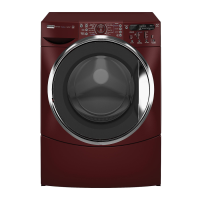




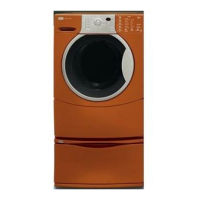
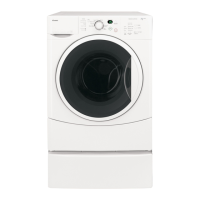
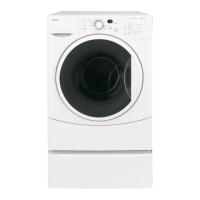
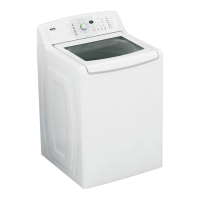
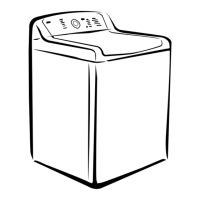


